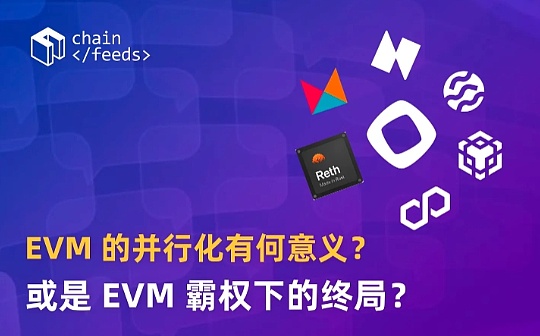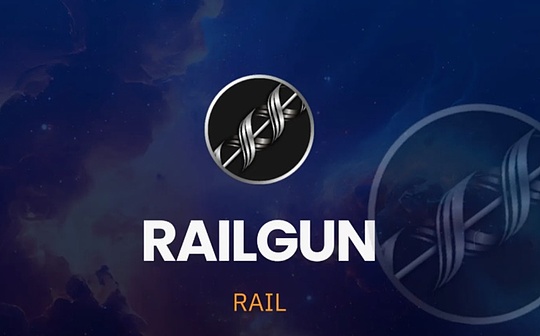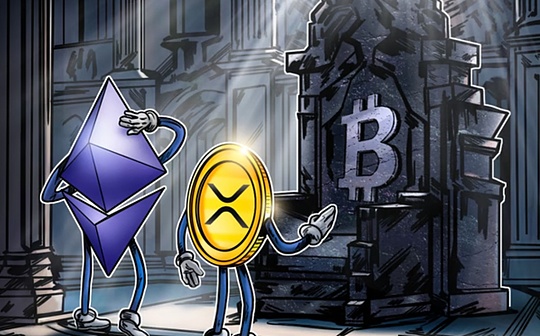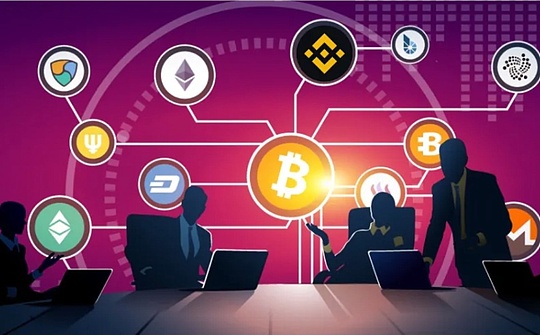
Author: zhixiong Pan, Source: Author Blog
Tl; DR
Parallel EVM concept is betting by several head VCs: Paradigm, JUMP, Dragonfly, etc.
The representative project is Monad, and there are SEI, MEGAETH, Polygon, Neon EVM, BSC, etc.Some are L1, and some are L2.There is no complete public information for the specific differences of each team.
Although Parallel EVM only represents “parallelization” literally, it is actually a special optimization of the performance of each component of EVM, so its efforts are likely to represent the performance limit under the EVM standard.
Difficulty: In addition to the rectification of the entire technology stack, there are also how to predict whether the parallel transactions will conflict in advance, and the re -execution efficiency after the conflict is encountered.
Challenge: How to find a balance between open source ecology and how to find a balance between decentralization and performance.
After the consensus algorithm, DA (data layer), and zero knowledge proof technology have been widely studied and iterated, the next hard -notch hard core technology is Parallel EVM. The capital market has also bet over hundreds of millions of US dollars for this narrative, and it has produced multiple independences.The horn -level start -ups.
The community began to follow Parallel EVM (EVM parallel))originThe same keywords mentioned at the Georgios Konstantopoulos (CTO of Paradigm) and Dragonfly’s Haseeb Qureshi.But there are not many details of discussing this topic, and many people think that this is not a new concept.EVM and parallelization calculations are relatively mature concepts, respectivelyWhy is it an important trend to combine these two words?
But this is still a very niche topic, so that if many research institutions’ annual summary and trend predictions are seen, Parallel EVM is not mentioned.So this is still a new concept that has not formed a large -scale consensus.And this concept is similar to the topics such as consensus algorithms, DA and other topics, all of which are related to pure technology, so there are fewer people who follow.
The most direct advantage of Paralle EVM isLet the existing decentralized applications realize the performance of the Internet levelEssenceIt can even be said that Parallel EVM is the only new technology that can use high -performance and parallelized public chain throughput while using existing smart contracts that can use (a large number of mature).
Paradigm is looking forward to the entrance for a long time, and JUMP is re -annotated
According to “wealth”ReportParadigm is planning to levate Monad’s latest round, raising $ 200 million with a valuation of $ 3 billion.Although this is the first Parallel EVM concept team invested by Paradigm, in fact, they have paid attention to this technology for many years. Georgios KonstantopoulosRefer toThis word.
The source of the word Monad is also very interesting.In the philosopher Leibniz’s philosophical system, Monad is the basic element of the universe. They are inseparable and unsatisfactory entities. Each Monad reflects the entire universe and has been translated as “single” in Chinese in Chinese.Essence
In computer science, Monad is a design pattern in functional programming language. It helps programmers to handle the complexity of the real world with the purity of nearly mathematics, making the code more modular, easy to understand and maintain.
Another interesting thing is that Monad and NOMAD are “Anagram”, Nomad refers to nomads, while Digital Nomad is an index nomad/digital herdsman.
Except for Monad, GeorgiosdiscussThis topic also mentioned SEI and Polygon.However, there is an important reason for his optimistic Parallel EVM, that is, they have developed a Ethereum client RETH.Its positioning is the high -performance Ethereum executive client, which is implemented in Rust language.Reth is developing at a fast speed and has just entered the Beta stage.Perhaps they will consider achieving Parallel EVM directly on Reth, but considering the amount of engineering research and development, it may be a better choice to promote Parallel EVM by investing in other teams.According to Monad documents, they mainly use C ++ and Rust in engineering.
At the beginning of the launch of Roneh, members of the Ericon team accused of plagiarizing its Akula’s open source code, which also led to the lack of funds for the Akula project to stop developing.Georgios responded that Reth is not a bifurcation of any other client, and the code does not come from any other client, but it is indeed influenced and inspired by Geth, Ericon, and Akula.((https://theDeFiant.io/paradigm-ACCUSED-COPYING-CODECure
Another core participant is Jump Trading and Jump Capital. The founder of Monad comes from Jump Trading and has rich experience in high -frequency transactions. Investors of SEI have JUMP Capital, and JUMP has also participated in the Solana ecosystem, including infrastructure construction and projects and projects.Essence
Dragonfly, the early investor of Monad, has also been paying attention to related tracks. He has invested in NEAR, which focuses on clipping technology, as well as public chains such as Aptos, Avalanche, Nervos.
The upgrade consensus algorithm is not enough, it is finally the turn of the execution level
In the past few public chain war, the execution level has been ignored. They almost only talk about the innovation of consensus algorithms, whether it is Solana, Avalanche or EOS.Although they have many innovations at the execution level, the community still remembers the consensus algorithm they use, and the entire community will think that these high -performance public chains can get these performances from the innovation of consensus algorithms.
But in fact, if you want to obtain a high -performance public chain, the consensus algorithm and execution layer need to be supported, and it also meets the short -board effect of the barrel.For those public chains based on EVM and only improve the consensus algorithm, it requires stronger nodes to improve performance.For example, refer to the GAS that the BSC can process at the level of 2000 TPS, and the required machine configuration is several times the investment of the Ethereum node.Polygon>>>>>>>>>>>>>>>>>>>>>>>>>>>>>>>>>>>>>>>>>>>>>>>>>>>>>>>>>>>>>>>>>>>>>>>>>>>>>>> for “>>>>>>>>>>>>>>BSC archive nodeNeed at least 16 core CPUs and 128G memory,>Ethereum nodeJust at least 4 cores CPU and 16G memory.
The BSC team has long been aware of these problems, so it is also with NodeReal>>Cooperative developmentParallel EVM technology.Only in this way can the number of transactions be processed by each block can be further increased, more transactions are executed in parallel, and the upper limit of the TPS is enhanced.
Parallel: not only upgrade from single -core to multi -core CPU
In most blockchain systems, the transaction is fully implemented in order. You can imagine it as a single -core CPU. After the current calculation is completed, the next calculation can be performed.Although this method is slow, its advantage is simplicity and low system complexity.
However, if the blockchain system needs to access the Internet -level user scale in the future, the single -core CPU is definitely not enough.Therefore, the parallelization virtual machine that is upgraded to a multi -core CPU can handle multiple transactions at the same time and increase throughput.However, there are many challenges in the implementation of the project. For example, what should I do if the two transactions handled at the same time are written into the same smart contract?It is necessary to design a new set of mechanisms to resolve this contradiction.For the parallel execution of other completely unrelated intelligent contracts, the number of threads that can be treated in parallel can increase throughput.
In addition, Parallel EVM not only improves parallel ability, but also optimizes the execution efficiency when single threads.Monad Ceo Keone Hon>express“… (EVM) The real bottleneck is to read and write the state frequently when handling things …”.He also said that parallel execution is only part of the roadmap. Monad’s greater mission is to surround EVM to make it as efficient as possible.
Therefore, although Parallel EVM only represents “parallelization” literally, it is actually a special optimization of the performance of each component of EVM, so its efforts are likely to represent the performance limit under the EVM standard.
EVM is not equal to solidity
Writing smart contracts is an essential skill for most blockchain developers.Engineers can write corresponding logical implementation in high -level languages in Solidity or other smart contracts according to business needs.But EVM does not actually understand the logic of solidity directly. It needs to pass some “translation” to translate it (compiled) as a low -level language that can be understood by a machine (OPCODE operating code/ bytecode byte code) in order to be virtual machineimplement.The process of translation, Solidity developers do not need to understand, because there are already mature tools.
After all, it is a “translation”, so there will also be some overheads (extra expenses).For engineers with underlying code experience, they can directly write programming logic in Solidity, so that they can achieve the highest efficiency, that is, users can save GAS when trading.For example, the Seaport protocol launched by OpenSea uses a large number of inner joint compilations in smart contracts to reduce GAS expenditure for users as much as possible.
Therefore, if the Parallel EVM can be finally realized, it will not only bring the ability of parallelization, but also optimize the performance of the entire EVM stack.Ordinary application developers do not need to spend huge energy optimization in order to save a little GAS, because the underlying virtual machine is already strong enough to smooth these differences.
EVM performance is different, “standard” is not equal to “engineering practice”
The “virtual machine” can also be called “execution layer”. It is an engine that is finally calculated and processed after the smart contract is compiled as the operating code.The “Byte Code” defined by Ethereum Virtual Machine (EVM) has now become an industry standard. Whether it is based on Ethereum’s two -layer network or other independent public chains, they are more willing to directly and complete the EVM standards.Those who write a smart contract can be deployed to multiple networks, and the cost performance is extremely high.
Therefore, as long as the “bytecode” standard of EVM can be fully compatible, it can be called EVM, but the implementation method can be very different.For example, the EVM standard in the Ethereum client GETH achieves the EVM standard in GO language.But the Ethereum Foundation’s executive research team IPSILONmaintainAn EVM developed with C ++ is independently implemented. Other Ethereum clients can directly call this library as an EVM execution.
For example, many industrialized products have their corresponding international standards. For example, when a product is issued, it needs to meet the value of the colonies less than a specific value to sell. This is the “standard”.But how to meet the standard of this factory, each factory can choose from dozens of different sterilization methods, and some factories can find a more cost -effective way to meet this requirement. This is “practice.”
SinceEvmoneThe implementation can also be done.Therefore, in this example of EVM, the EVM standard is to define some basic operation methods “bytecode” (such as supporting the most basic arithmetic such as addition, subtraction and multiplication). When each bytecode has a certain input, there isDetermine output.When satisfying this standard, the implementation (practical) method is different, and there are a large number of custom space and engineering optimization possibilities.
The similarities and differences in Parallel EVM
In the Parallel EVM track, in addition to the hottest Monad, there areSEI, Megaeth, Poygon, NEON EVM, BSCWait, and Paradigm’s RETH client also wants to implement parallelization functions.
From the perspective of positioning, Monad, SEI, POLYGON, and BSC are all Layer 1 blockchain, and Megaeth may be Layer 2, neon EVM is based on Solana network.In addition, RETH is an open source client, and MEGAETH will also be partially developed based on RETH -based projects.
Of course, there are still competitive relationships between these teams, and they have not fully disclosed all technical details and engineering documents. More comparisons need to be gradually disclosed in follow -up.Perhaps this is like the arms race, like BTC Layer 2, RESTAKING, Ethereum Layer 2. Although there are slight differences (and open source) between technology, it is more important to build the uniqueness of ecology.
Parallel EVM’s technical difficulties
For transactions in order, the bottleneck lies in the process of CPU and reading.But the advantage is that this method is simple enough to not make mistakes, and all transactions can be completed step by step.For virtual machines that are executed in parallel, there may be state conflicts, so you need to increase this part of judgment before or after execution.
A simple example is that if the virtual machine supports the four threads to perform parallel and each thread can handle a transaction at the same time. In case of these four transactions is trading on the same trading pool on the Uniswap, then it cannot be parallel to parallelCalculated that the transaction price of the trading pool will affect the transaction price of this transaction pool after each transaction.But if these four threads handle four completely irrelevant things at the same time, then there is no problem.
This will involve the design and engineering implementation of different teams, but at least it must be ensured that a module is needed to detect the conflict after parallel execution.Of course, if you can predict and screen in advance, there may be conflict transactions, and the parallel efficiency of the entire virtual machine can also be increased.
In addition to the differences in engineering implementation of the Parallel EVM virtual machine, each team will generally redesign and enhance the read and write performance of the status database, and support the design of a consensus algorithm, such as MonadB and MonadBFT designed by Monad.
challenge
For Parallel EVM, there are two challenges that may exist: whether the long -term engineering value will be captured by Ethereum; the centralization of the node.
Because each team is still in the development and testing phase in Parallel EVM technology, I have not chosen all the details of all engineering projects. This is one of the current moats.However, after entering the test network and the main network, these engineering documents will be made public, or it may be absorbed by Ethereum or other public chains.Therefore, at that point, it is necessary to promote ecological construction faster and build more ecological moats.
However, this problem is not so serious. On the one hand, for Crypto developers, there are more open source licenses to choose from now (such as the one of Uniswap can make the code open, but the fork is not allowed to be a business project).On the other hand, the positioning of Monad is different from Ethereum.Even if Ethereum can realize the end of the single slot (SSF) in the future, the final nature of the transaction is still at least 12 seconds, which is not enough for higher -frequency application scenarios.
Another challenge is the same for all high -performance public chains, that is, how to deploy more nodes to meet the basic requirements of users’ no -licensed (Permissions) and Trustless: decentralization.Perhaps there are some indicators of this, such as “TPS except for the hardware requirements of nodes”, so that control variables can be achieved. Compared with the standards of specific hardware requirements, which public chain/client has higher TPS.After all, the lower the hardware requirements of nodes, the more nodes may be.
Next, we will continue to track the progress of each project of Parallel EVM and discuss their technical and differences in detail.








